central nervous system



Here is a supplementary video screencast of Neurodegenerative Diseases and CNS Effects of Alcohol.
To change the video speed, please refer to the Video Speed and Virtual Pots Instructions page.
If you can't play the video, watch it here on YouTube: https://youtu.be/qyFfGv4WQSM
The mindmaps below provide a summarised overview of the main pathologies involving the CNS.
These are not comprehensive, but, rather provide a big picture view.
MINDMAP: CNS Pathology I - Raised ICP and Intracranial Haemorrhage
If you can't play the video, watch it here on YouTube: https://youtu.be/yt8512FdynQ
MINDMAP: CNS Pathology II - CNS Tumours and Infections
If you can't play the video, watch it on YouTube: https://youtu.be/qV_3GhBwhck
4 Comments
Leave a Comment
You must be logged in to post a comment.

Hi Dr Nga!
Could I find out why a venous thrombus in the CNS would result in pale/bland infarct, when elsewhere in the body it usually results in congestion (red)? Thank you! 🙂
Hello,
Venous thrombosis in the brain certainly can lead to haemorrhage, but still in the context of obstruction and ischaemia, i.e. the primary pathology is an occlusive one rather than cerebral haemorrhage. Ischaemia due to vascular occlusion can result in either bland or haemorrhagic infarcts. The arterial imflow is also compromised when there is a venous occlusion, hence the ischaemia. According to the literature, about half of venous thrombosis cases show evidence of haemorrhage.
I hope this helps clarify!
Hi Dr Nga! Do you mind explaining why then, do embolic causes tend to result in haemorrhagic infarcts then?
Hello, the embolic infarcts tend to have a higher change of dissolution of the embolus and hence recanalisation (vessel reopening) and this is thought to bring about the risk of reperfusion injury – with bleeding through vessels damaged by ischaemia. There may be other mechanisms as well, but this is the most generally documented cause. It is briefly described in Robbins. You can read on this and other suggested mechanisms of haemorrhage here: http://www.strokecenter.org/professionals/brain-anatomy/cerebral-embolism-formation/hemorrhagic-conversion/